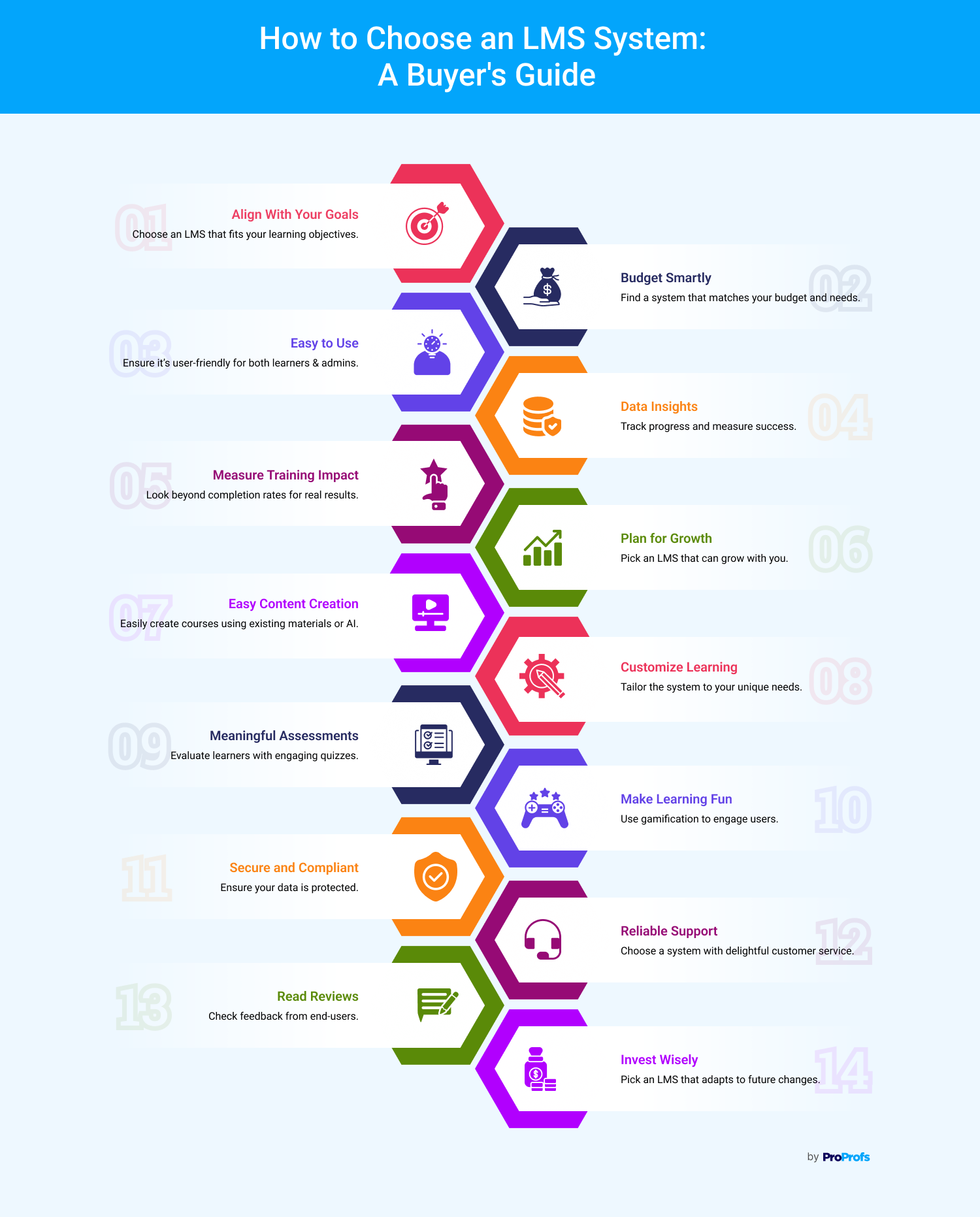Investing in an LMS often feels like a gamble, and here’s why: according to Brandon Hall Group, only 8% of employees love their LMS, while 27% outright hate it.
Issues such as clunky interfaces, poor reporting features, and subpar support have pushed nearly half of organizations to consider replacing their LMS. I’ve faced this frustration firsthand when I chose an LMS that couldn’t meet my growing team’s needs.
That’s why I’m here to guide you. Let’s identify how to choose an LMS. I will help you understand what works and ways to avoid common pitfalls when choosing an LMS. Together, we’ll find a solution that doesn’t just function but thrives in your unique business environment.
What Is an LMS?
An LMS is a software application designed to create, manage, deliver, and track online training or educational programs. It serves as the central hub for learning in an organization or institution, where you can assign courses, track employee progress, and analyze performance all in one place.
For businesses, it simplifies corporate training, compliance, and skill development. For schools, it provides a platform to distribute lessons and interact with students. Popular LMS platforms often include features like virtual classrooms, gamification, learning paths, and detailed reporting to ensure efficient training and measurable outcomes.
Why Choose a Learning Management System?
Before choosing a learning management system, let’s ask the bigger question: why should you choose one in the first place? An LMS is the backbone of modern training strategies. Here’s what makes it essential:
- Centralized Learning: No more juggling scattered materials. An LMS gathers all your training content in one place, making it easier to manage and share across your organization.
- Scalability: Whether you’re a startup or an enterprise, an LMS grows with your team and effortlessly adapts to your business needs.
- Customization: Why settle for one-size-fits-all? Modern LMS platforms let you personalize everything, from the interface to the course content, so it aligns with your brand.
- Integration Capabilities: Connect your LMS with other systems, such as HR software and CRMs, to create a seamless flow of data and improve efficiency.
- Analytics & Reporting: Track progress, measure training success, and generate actionable insights with robust reporting tools.
- Compliance Management: Simplify audits and meet industry regulations with built-in compliance features that log certifications and completed courses.
- Cost-Effectiveness: Save money on travel, printed materials, and other traditional training expenses by centralizing and automating the process.
- Mobile Accessibility: Keep learning flexible. Learners can access training anytime, anywhere, using smartphones or tablets.
- Gamification & Engagement: Increase participation with gamified features like badges, leaderboards, and rewards that keep learners motivated.
- Security: Protect sensitive training data with top-tier encryption and user authentication features.
The advantages are clear: With an LMS, your training becomes smarter, faster, and more effective.
Still not convinced? No worries! Check out this case study:
What Are the Key Features of an LMS?
Now, let me explain the features and walk you through what makes an LMS tick:
- Course Management: An LMS lets you organize all your training materials in one place. That’s what course management does. You can upload content, set up modules, and schedule lessons. Whether it’s videos, PDFs, or quizzes, it’s all under one roof, ready to be accessed by your team.
- User Management: Managing users becomes effortless with LMS software. You can add new learners, remove inactive ones, and even group them based on roles or departments. Think of it as a digital HR assistant for training.
- Learning Paths: Not everyone learns the same way, right? Learning paths let you create step-by-step progressions tailored to different skill levels or roles. It ensures each learner gets precisely what they need when they need it.
- Assessment Tools: How do you know if your training is working? That’s where assessment tools come in. You can set up quizzes, tests, and certifications to measure progress and track understanding. It’s all automated, so there are no grading headaches.
- Virtual Classrooms: Say goodbye to scheduling in-person training sessions. Virtual classrooms let you host live online webinars, interactive sessions, and group discussions. It’s like bringing the team together, no matter where they are.
- Gamification: Let’s make learning fun, shall we? With gamification, you can add badges, leaderboards, and rewards to your courses. It keeps learners motivated and turns training into something they look forward to.
- Mobile Access: People are always on their phones, so why not make learning mobile-friendly? In fact, Americans check their smartphones an average of 144 times per day. Most LMS platforms allow access from smartphones and tablets so that training can happen anytime, anywhere.
- Analytics and Reporting: This feature is your secret weapon. It tracks progress, highlights areas for improvement, and gives you insights into the effectiveness of your training. Think of it as having a bird’ s-eye view of your learning program.
How to Choose an LMS System

Choosing an LMS system is a big decision. It’s the platform that will house your training materials and learner groups, track their progress, and ultimately support your organization’s learning & development initiatives.
But with so many features to consider, where do you even begin? Let’s consider the key factors when choosing the right LMS.
Oh, wait, no time to read the whole thing? Here is a quick video for you
1. Understand Your Needs
Why: To know how to buy an LMS, you must first identify your training goals. Aligning the LMS with your goals ensures it provides the features and functionalities you need. Are you training new employees on company policies (onboarding)? Do you need to deliver mandatory safety regulations (compliance)? Or are you offering ongoing skill development programs (professional development)?
How: Set SMART goals (Specific, Measurable, Achievable, Relevant, and Time-bound) for your training programs. This clarity helps you select an LMS that effectively supports achieving those goals. For instance, a goal of “improve customer service skills by 10% within 3 months” requires tracking metrics beyond just course completion rates.
2. Know Your Budget
Why: LMS solutions have different pricing models. There can be upfront licensing costs, ongoing subscription fees, and additional features or storage space charges. Aligning your budget with the LMS cost structure ensures you get the most value for your investment.
How: Consider upfront costs, ongoing subscriptions, and potential additional fees associated with different LMS options. Choose an affordable LMS that fits your financial resources without compromising essential features.
3. Look for User-Friendly Experience
Why: An intuitive and user-friendly LMS is essential for administrators and learners. A smooth user experience keeps everyone engaged with the platform, leading to better learning outcomes.
How: Look for an LMS with a clean and easy-to-navigate interface. Administrators should be able to manage courses, users, and reports efficiently. Learners should be able to find and access learning materials, complete courses, and take assessments effortlessly.
4. Robust Tracking & Analytics
Why: Robust reporting and analytics are crucial for measuring the effectiveness of your training programs. With LMS tracking and analytics, you can track learner progress, identify knowledge gaps, and analyze engagement metrics. This will help you make data-driven decisions to improve your training initiatives.
How: Choose an LMS with comprehensive reporting features that allow you to track various data points. This includes course completion rates, quiz results, learner activity within courses, and time spent on materials. Analyze this data to identify areas for improvement and ensure your training programs meet your goals.
5. Must Support Mobile Learning
Why: Flexibility is key when it comes to training. Employees or learners often prefer learning on the go, during a commute or break. Mobile LMS ensures learners can access courses anytime, anywhere, boosting engagement and convenience.
How: Opt for an LMS with a responsive design or dedicated mobile apps. Ensure all course content, videos, and quizzes are optimized for smartphones and tablets. Test the platform to confirm the mobile user experience seamlessly matches desktop capabilities.
6. Options for Customization
Why: No two organizations are the same, so your LMS shouldn’t look like everyone else’s. Customization ensures the platform reflects your brand and unique training needs. From branding to course security, you want an LMS that adapts to your business, not vice versa.
How: Choose an LMS with white-labeling options to display your logo, colors, and brand identity. Look for features like password protection, chapter locking to prevent skipping, and settings to establish compliance rules. Bonus points if the LMS automatically sends reminders for overdue courses!
7. Gamification and Social Learning
Why: Training doesn’t have to be boring. eLearning gamification and collaboration features can turn learning into an engaging experience. Rewards, leaderboards, and social interaction encourage friendly competition and knowledge sharing.
How: Select an LMS with gamification elements like badges, points, and brain games that challenge and reward learners. Add collaboration tools like forums or group discussions so learners can share ideas, solve problems, and grow together. Think fun and interactive, not dry and transactional.
8. Assessments and Quizzes
Why: Training without assessments is like teaching without feedback—it’s impossible to measure success. Quizzes help evaluate knowledge retention and highlight areas where learners need extra support.
How: Look for an LMS that offers versatile assessment types, from multiple-choice to scenario-based quizzes. Make sure it supports automated grading and instant feedback.
Pro tip: Include timed quizzes and randomized questions to keep learners on their toes!
9. Opportunities for Feedback Collection
Why: Your learners aren’t just participants but a goldmine of insights. Collecting their feedback can help you improve courses, identify gaps, and refine your training strategy.
How: Choose an LMS with built-in survey tools or feedback forms. Adding surveys after the course is a must. Ensure the LMS allows anonymous feedback to encourage honest responses. Use this data to enhance the learning experience and make it more relevant.
10. Scalability & Adaptability
Why: Technology evolves rapidly, and your LMS should keep up. Whether your organization grows or the market introduces innovations like AI, your LMS should be ready to scale and adapt.
How: Choose a platform designed for scalability to support your growing team without breaking a sweat. Look for an AI LMS with features like AI course creation, personalized course recommendations, predictive analytics, and adaptive learning paths. Your LMS should evolve alongside your business, always ready for what’s next.
Get Free LMS Software — All Features, Forever.
We've helped 567 companies train 200,000+ employees. Create courses in under a minute with our AI LMS or use 200+ ready-made courses on compliance, harassment, DEI, onboarding, and more!
Tips for Avoiding Mistakes While Choosing an LMS
I have seen that most buyers make one mistake or the other when choosing an LMS. They often ignore user experience, overlook integration capabilities, and fail to consider long-term costs. These mistakes lead to dissatisfaction and hinder learning outcomes. Choosing the right LMS requires careful evaluation of features, pricing, support, and scalability.
Here are some commonly made mistakes and how to avoid them.
1. Not Defining Your Needs
Before looking at LMS options, clearly define your training goals and what features are essential. What kind of content will you be delivering? How many learners will you need to support? A clear idea of your needs will help you narrow your choices and avoid getting bogged down in features you don’t need.
2. Focusing on Price Alone
While cost is obviously a key factor, the cheapest option may not be the best in the long run. Consider the total cost of ownership, including implementation, training, and ongoing support.
3. Neglecting User Experience
The LMS should be easy to use for both learners and administrators. Try out free trials or demos to see if the interface is intuitive and the platform offers the needed features.
4. Ignoring Scalability
Think about your future needs. Will you need to add more learners or courses down the road? Make sure the LMS you choose can scale to meet your growing demands.
5. Underestimating Implementation
Implementing a new LMS can take time and effort. Factor in the time it will take to migrate your content, train your administrators, and get your learners up and running.
Transform Your Team with the Right Learning Management System
Effective training is no longer optional. It’s essential for growth. Your competitors are investing in learning and know the power of a good LMS. So, don’t be left behind. The right LMS can transform your team, boost their skills, and help them to be more productive.
Choosing the right LMS is a strategic move and an investment in your future. Don’t delay. Explore your options. Find the perfect fit and give your team the tools to succeed. The future of learning is here. Be ready.
Frequently Asked Questions
Who uses an LMS?
Organizations of all sizes, educational institutions, and individuals use LMS for training, learning, and development.
Which is the best LMS for my organization?
The “best” LMS depends on your specific needs, budget, and required features. Research and compare options.
Can an LMS be customized for my organization’s needs?
Yes, LMS platforms offer customization options, including branding, workflows, and integrations.
What factors should I consider when setting a budget for an LMS?
Consider licensing fees, implementation costs, training, maintenance, and potential customization expenses.
Can I integrate an LMS with other tools my organization uses?
Yes, most LMS offer integrations with HR systems, CRM, and other relevant business tools.
How long does it take to implement an LMS?
Implementation time varies based on complexity, chosen LMS, and organizational readiness. It can range from weeks to months.


 We'd love your feedback!
We'd love your feedback! Thanks for your feedback!
Thanks for your feedback!








